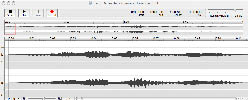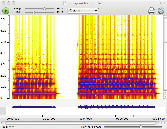A performing musician devotes mental energy to two mutually dependent but distinct tasks: production of musical sounds and assessment of one’s own performance. A continuous feedback loop occurs, and careful listening leads to adjustment of phrasing, intonation, balance, style, tone, etc. There is a limit, however, to how much mental energy one can devote to each task, and one becomes more perceptive when merely listening and not performing. Listening to a recording of one’s own performance focuses attention and brings to light details that one does not otherwise notice.
An informal survey of colleagues on many instruments and voice reveals that there is widespread use of audio recording in teaching. Teachers employ a range of recording media, from reel-to-reel or cassette tape recorders, mini-disc recorders and DAT machines to current technology including CD recorders, Mp3 recorders, multi-track recorders, or computer software. A wide selection of recording software is available for both Windows and Mac operating systems, from freeware1 to professional studio systems. I record students on a MacBook Pro using Amadeus Pro software.2 Digital audio quality is high, editing and navigation are easy; the software includes useful analysis tools; and most importantly, the visual editor provides a graphic record that helps students become more perceptive aurally.
Studio teachers use recording in a variety of ways. Some merely review recorded performances during lessons. Some require students to record entire lessons for later reference. Some record each lesson and e-mail the recording or burn a CD for the student. Some record studio classes and make them available through a secure website. Some require students to record part of their assignments and bring the recording to the teacher. Some keep an audio portfolio to document a student’s progress over the long term. I use recording only when a student needs a heightened awareness of a specific aspect of her performance. My primary method of using recording is: (1) I model the passage; (2) the student plays the passage; (3) on playback, we compare our performances visually and aurally. This procedure stimulates a detailed discussion of the differences between our performances.
Less experienced students often think they are making dynamic differences when none are apparent. Graphical displays clearly demonstrate dynamics or the lack thereof, on the level of a phrase and an entire work. Figure 1 shows a two-minute work that has a simple dynamic shape: piano, crescendo poco a poco to a sustained fortissimo, and diminuendo sempre più to niente. In this performance each phrase intensifies, there is an obvious climax at the exact midpoint, and a gradual taper to the end.
Figure 1. Graphical display of Ingolf Dahl’s Variations on a Swedish Folktune for flute alone, Variation IV, showing overall dynamic shape.

Recording is invaluable in teaching rhythmic precision and steadiness. If there is a rhythmic problem, my students conduct and speak subdivisions while listening to playback and thus can sense when the pulse is unsteady or a note is too long. Some students are unaware of their tendency to play behind the beat, and recording with a metronome brings this to their attention. Evenness and clarity of technique and articulation in fast passages are difficult to ascertain in real time. Recording software allows playback at slower speeds and lets one pinpoint exactly which notes are faster than others. This is comparable to looking at an object under a magnifying glass.
Visual clues, such as breaks in the line or abrupt changes in quality or dynamic between notes, lead one to perceive the absence of legato. Figure 2 is a recording of a legato passage in which the vibrato starts and stops between notes and there is a disruptive bulge in the middle of each note, destroying a sense of continuity.
Figure 2. Graphical display of Arthur Honegger’s Danse de la chèvre for flute alone, showing breaks in the legato line.

Recordings reveal many aspects of tone: purity, fullness, beauty, and timbre. I teach students to vary tone color by using spectrum analyzers and sonograms available with many audio software programs. Figure 3 compares a note played first with an “open” tone with fewer overtones to a note played with a more penetrating tone rich in overtones.
Figure 3. Sonogram of A-440 played on the flute first with fewer and then with more overtones.

Audio recording software can demonstrate fluctuation in pitch, loudness, and timbre within a vibrato as well as vibrato rate. The lower portion of Figure 3 shows a vibrato pulsing at a rate of five times per second. The upper portion of Figure 3 shows upper harmonics bouncing in and out at a regular rate. Slowing down a recording makes the pitch fluctuation apparent and surprisingly wide. As a modeling exercise for vibrato, I assigned each of my students to find one favorite note on any professional recording. We loaded the sound file onto my computer. After recording the student playing the same note, we compared the student’s vibrato aurally and visually with her model. The graphic display facilitates matching of vibrato depth and speed.
Robert Philip has detailed how the advent of recording in the early twentieth century made musicians more self-conscious, literal, accurate, and less spontaneous.3 Nevertheless, in addition to its utility for focusing on details, recording can make one aware of the big picture. Hearing playback of an accurate but inexpressive or lifeless performance certainly makes one want to do better. Audio recording is an important tool in my pedagogical arsenal. It leads students to become more perceptive about their performances, and visual clues in audio software enhance listening acuity. This greater acuity leads to a better ability to evaluate one’s own performance.
Bibliography
Philip, Robert. Early Recordings and Musical Style: Changing Tastes in Instrumental Performance, 1900-1950. New York: Cambridge University Press, 1992.
Endnotes
Editor's Note: This article appeared previously in the NACWPI Journal, Volume 59, no. 1 (Fall 2010), pp. 18-21, and is included with permission of the National Association of College Wind and Permission Instructors.
1Audacity by Soundforge (http://audacity.sourceforge.net/).
3Philip, Robert. Early Recordings and Musical Style: Changing Tastes in Instrumental Performance, 1900-1950. New York: Cambridge University Press, 1992.


